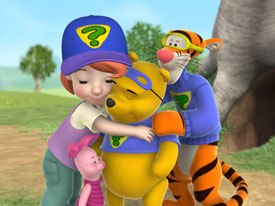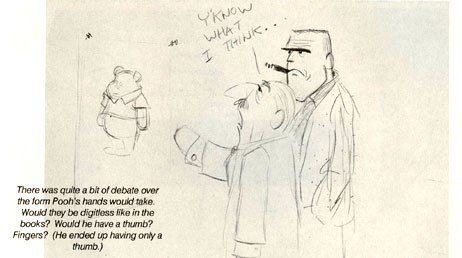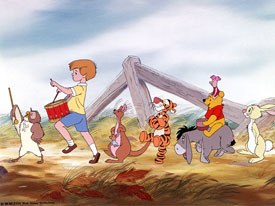John Cawley chronicles Winnie the Pooh's long history in film, leading up to his new CG incarnation in My Friends Tigger & Pooh.

CGI comes to Winnie the Pooh with My Friends Tigger & Pooh, a new series created for Disney's pre-school block, Playhouse Disney. Unless noted, all images © Disney Enterprises. All rights reserved.
For a bear with very little brains, Winnie the Pooh has been very smart in his ability to adapt. More than 80 years after his first print appearance (1926), this bear "stuffed with fluff" has managed to be a bear for all seasons. This year he evolves into a character with depth thanks to a new CGI series, My Friends Tigger & Pooh, debuting on the Disney Channel, May 12, 2007, at 10:00 am. It will mark the fourth TV series to star A.A. Milne's classic ursine, on top of his numerous shorts, specials, features and videogames. Pooh even has a star on Hollywood Boulevard! Perhaps the most amazing thing is that Pooh represents a time when Walt Disney made a mistake -- but more on that later.
Pooh's latest venture, My Friends Tigger & Pooh is a CGI rendition created by Walt Disney Television Animation for Disney's pre-school block, Playhouse Disney. The person behind the series is Brian Hohlfeld, a fellow who has spent the last few years with Pooh in the Hundred Acre Woods. Hohlfeld began in the business writing live-action features like He Said, She Said. However, he found the writing business spotty, so he packed up his family and moved to St Louis.
Soon after, he heard from a friend that he had worked with writing material for The Mighty Ducks. It seemed Disney was looking for someone to write a Pooh holiday special. Hohlfeld quickly agreed. Though the eventual special got shelved, Hohlfeld was asked to write the script for Piglet's Big Movie (2003). The team of Hohlfeld and Pooh was born. Hohlfeld handled writing chores on the next few Pooh projects, including the theatrical, Pooh's Heffalump Movie (2005).

Floyd Norman's studio gag drawing shows Walt Disney debating how to imagine Pooh's hands. From Norman's FASTER! CHEAPER! published by Get Animated! Reproduced with permission.
Finally, Hohlfeld got the chance to build a new series. The premise was to create an interactive show around the Pooh characters. Hohlfeld felt that one of the dreams many kids have is to actually visit the Hundred Acre Woods. So the idea of bringing a contemporary friend into the environment was born. The result was Darby, a young tomboy of a girl who plays with Pooh and his friends. It was decided not to give her any sort of backstory. So she is not explained as a "friend" or "neighbor" of Christopher Robin. She is just another child visiting the woods.
Each story involves a problem that ensures that the characters will call to the audience to help. "I think an educational series is almost organic to Pooh, who often has to 'think, think, think' in the stories," explained Hohlfeld.
The press sheet states, "Each endearing episode presents an intriguing mystery for Darby, Pooh and Tigger to unravel. To discover the answer, they don homemade superhero costumes to transform themselves into the Super Sleuths, a trio of dedicated problem solvers. Each member of the group brings their own unique perspective and talent to the perplexing puzzler, as they work together to analyze the situation. Along the way, the friends -- and viewers at home -- learn to apply 'reflective' thinking skills and learn important lessons about cooperation and responsibility"
As mentioned, Pooh has been able to adapt to every need. As a children's classic, the stories and best-known illustrations by E.H. Shepard were legend. Pooh might have been simply another children's book bear, had not Walt Disney stepped in and acquired the rights in 1961. Walt envisioned a feature starring the popular characters. He put some of his best creative talent on the project, including his new finds, the Sherman Brothers. But as production dragged on, Walt felt that Pooh was just "too soft" for an American audience.

The new series introduces a contemporary friend to Hundred Acre Wood. Young tomboy Darby, Pooh and Tigger don homemade superhero costumes and become Super Sleuths to solve mysteries in every episode.
During one story meeting, Walt confessed that American audiences would not support a feature. He told his artists they would have to "go the hard way" and just make a short. (Being "hard" meant that the studio would have to work as hard as on a feature, but without the financial rewards of a feature release.) The Sherman Brothers recalled that during that meeting Walt walked along the storyboards, then stopped where Pooh was stuck in a honey tree. He pointed to the drawings and said, "This is where the short will end."
Winnie the Pooh and The Honey Tree debuted in 1966, as a short with The Ugly Dachshund. The brightly colored featurette introduced the world to the Sherman Brothers favorite Winnie the Pooh song. Animated by a number of Disney's "Nine Old Men," it also featured classic Disney voice work with Sterling Holloway (Dumbo and Peter and the Wolf) as Pooh, Barbara Luddy (Lady of Lady And The Tramp) as Kanga and Ralph Wright (Disney artist and story man) as Eeyore. It also featured Bruce Reitherman (son of legend Woolie Rietherman and future voice of Mowgli) as Christopher Robin and Sebastian Cabot as the narrator (future voice of Bagheera in Jungle Book). Though the poster showed Piglet and Tigger, neither character appeared in the short.
The featurette attracted some interest, but it seemed that Walt was right. The characters did not take off. Walt died in December of 1966, never realizing what was to come. With so much work done, the studio went to work on the second third of the film. Winnie the Pooh and the Blustery Day arrived in 1968 with The Horse in the Gray Flannel Suit. It got nominated for an Oscar, and ended up winning for Best Animated Short Subject.
In order to train a new regime of animators, the studio put Winnie the Pooh and Tigger Too into production. It debuted in 1974 with Island at the Top of the World. The short was also nominated for an Oscar. But, more importantly, Tigger finally arrived. Where the soft spoken, simple Pooh may have been too gentle, the over the top, bouncy Tigger was perfect for U.S. audiences. Voiced by Paul Winchell, the character became an almost instant icon, and, at times, threatens to overshadow his buddy bear. In 1977, the studio reassembled the shorts into the original feature concept envisioned by Disney. The Many Adventures of Winnie the Pooh proved modestly successful at the box office.

Walt Disney's original concept for a Winnie the Pooh feature became reality when the studio reassembled three shorts into The Many Adventures of Winnie the Pooh in 1977. It proved modestly successful at the box office.
By then, Pooh merchandise was selling very well to the infant crowd. Pooh, himself, had begun to equal the mouse in power as an icon. He and his friends could be found on almost every type of merchandise. In 1972, a "Winnie the Pooh for President" promotion did very well at Disneyland. They attempted to repeat it in 1976, and planned a major parade and show promoting Pooh for President and Eeyore for Vice President. But, in an early sign of rebellion, the Milne estate objected to their simple bear being turned into a political creature. Disneyland dropped the promotion.
Pooh's world changed a bit for 1983's The House at Pooh Corner. This series featured a friendly human narrator who told stories acted out by performers in costume. The series debuted on The Disney Channel and was one of the young network's earliest hits. With the narrator often asking, "What would you do," it seems to have foreshadowed the newest series. It also did not have Christopher Robin.
For the new series, Hohlfeld is very specific for Christopher's absence. "Christopher is seen as a character that always helped solve the character's problems," stated Hohlfeld. "The point of this series is to show the characters solving their own problems. That is the reason we also did not use Owl. He is another problem solver."
After the full feature animation seen in the original shorts, some wondered if Pooh would survive going to TV animation. The New Adventures of Winnie the Pooh in 1988 answered that question. This popular series ran four years on ABC Saturday morning. Gone, along with the theatrical animation process, was a reliance on the original books. Most of them had been told in the shorts. And the Disney Studio felt that a Saturday morning series needed to be more adventurous. Also, this was the first series to use voice talent Jim Cummings as Pooh, and eventually Tigger.
Meanwhile, Pooh's feature career flourished with several films, including Pooh's Grand Adventure: The Search for Christopher Robin (1997), The Tigger Movie (2000), Piglet's Big Movie (2003) and Pooh's Heffalump Movie (2005). The Hundred Acre Woods gang also popped up in various TV specials like Winnie the Pooh and Christmas Too! and Winnie the Pooh, A Valentine For You. Pooh and crew evolved into Japanese Banraku style puppets for the Disney Channel's TV series, The Book of Pooh (2000).

Pooh's feature career flourished with several films including, Pooh's Grand Adventure: The Search for Christopher Robin in 1997 (right) and Piglet's Big Movie in 2003.
Moving Pooh into educational TV, as mentioned, was not difficult. At first, Hohlfeld, "found it a bit more restricting due to the need for a curriculum (lesson). But at the same time it was a bit freeing, because the lessons led to lots of story ideas." In production for nearly three years (only one and half in full production), Hohlfeld found the series itself evolving. "The first ones are more tied to the specific curriculum. Later, we started having more fun as the lessons became lighter in tone." For example? An early episode has the mystery solvers try to figure out what Roo should give to Kanga as a gift. In a later episode, "Darby becomes a giant after drinking one of Rabbit's formulas," explains Hohlfeld with a chuckle.
Also new to Hohlfeld is the amount of pre-production testing that goes on. "They take the first draft of the script and create an illustrated storybook to read to kids. This helps fine tune what kids really understand." He was surprised to find some ideas were a bit too abstract for the under five-year-olds. One pleasant surprise was how well the kids take to Buster, Darby's dog. There had been discussion as to whether Buster would talk. But it was decided to keep it "real" since it belonged to Darby who is "real."
Always important to the world of Pooh are the songs and ditties that Pooh and his friend hum or sing. The new series is no different. Music is by popular rock icon (and now animation music master) Andy Sturmer. Sturmer, who previously produced for such legends as Ringo Starr, Brian Wilson and Ozzy Osbourne, has recently become a top toon-tunesmith, creating title songs for such series as Teen Titans and complete scores for Hi Hi Puffy AmiYumi.
The lyrics are by Hohlfeld, himself. His career as a lyricist was a bit of serendipity. "It came by accident. When I was working on the Piglet feature, they brought in Carly Simon to write the music. They took several of the poems from the film and had her put music to them. It was everyone's assumption that they were authentic rhymes from Milne. However, I had to inform everyone that those were original ditties I had created for the script. Everyone loved them, and suddenly I was a lyricist."

Moving Pooh into educational TV was not difficult. At first, writer/producer Brian Hohfield found incorporating lessons into the story a bit restrictive, but ultimately he viewed them as story ideas.
As mentioned, Hohfield felt the character of Pooh, and his desire to "think" would work well in a pre-school environment. "I am really happy at how universal Pooh's world is. The characters do skew a bit young. But it is amazing at times. Two-year-olds already seem to know the characters and just love watching the color and movement. Four-year-olds are just about the right age. Five-year-olds like to watch, because it makes them seem 'smarter' than the characters."
I wondered if Hohfield missed writing more sophisticated adult comedies. "Not at all! I am a big fan of children's books. Being able to work on such a classic is wonderful." In fact, for Piglet's Big Movie, he incorporated the last Milne story that Disney had not yet presented. Is there another book he would like to adapt? "I think the Frog and Toad series by Arnold Lobel are great. I would love to do something with them in animation."
For the time being, Hohfield has his slate full. He is finishing up the first order of 26 half hours of My Friends Tigger & Pooh. Recently, he got word that the series was picked up for another season. Now he and his team will have to turn their caps around and "think, think, think" up more puzzlers for the new toon trio to tackle.
John Cawley is a producer of animation whose résumé includes Cartoon Network, Nickelodeon, New World/Marvel, Film Roman and Sullivan-Bluth. Cawley, an author of several books on animation, has also written for comics and animation. He is a lecturer on animation production and an established mascot performer.







